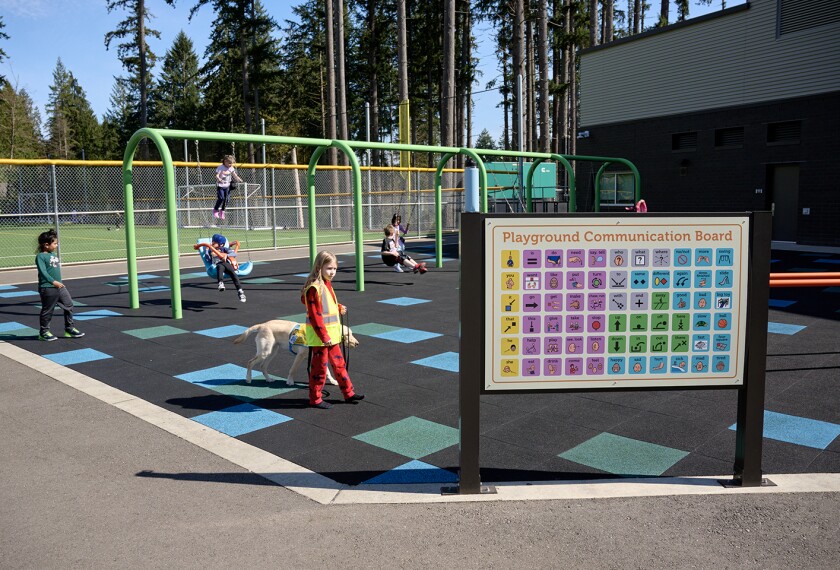How much do America’s schools spend to provide special education services to students with disabilities? How have special education costs nationwide risen over the last two decades? What is the typical cost of providing services to a K-12 student who has autism, or ADHD, or Down syndrome?
The answer to all of these questions is painfully simple: We don’t know.
Educators, policymakers, and researchers can make educated guesses. Some states collect data from school districts on special education spending. Some researchers have an inkling about the trajectory of special education costs so far during the 21st century, particularly as the proportion of America’s students receiving special education services has trended upward.
But the last detailed, nationwide study of special education spending, which can vary widely from state to state and district to district, was conducted 25 years ago.
That will begin to change in the coming years, though. Scholars who work for the U.S. Department of Education’s Institute for Education Sciences (IES) and the American Institutes for Research (AIR) are preparing to execute a pilot study that will lay the groundwork for a nationwide examination of the billions of dollars spent annually on special education.
This $5.2 million effort is a sequel of sorts to the Special Education Expenditure Project (SEEP), which was conducted during the 1999-2000 school year and published a few years later.
That project found that special education services cost $50 billion, or $8,080 per pupil requiring special education services during the 1999-2000 school year, working out to 21 percent of overall spending on public schools that year. Those numbers have undoubtedly changed, and almost certainly grown, since then.
“Someone I spoke to at an advocacy organization said [SEEP] is the oldest data she routinely cites,” said Claire Allen-Platt, a research scientist for the National Center for Education Evaluation and Regional Assistance, within the Institute for Education Sciences, who’s serving as project officer for the new study. “So much has changed since then that we think it’s important to update.”
New study will build on decades-old findings
Allen-Platt and her teammates hope the finalized will provide lawmakers with crucial context they’ll need during a potential reauthorization process for the Individuals with Disabilities Education Act, the federal law that enshrines students’ rights to special education.
When Congress passed that law in 1975, it committed to providing funding for all special education students equivalent to 40 percent of the nationwide average per-pupil cost of K-12 education. But as far as researchers and advocates can tell, the government has never come close to fulfilling that commitment, leaving states and local school districts to make up the difference, sometimes at the expense of other priorities.
If lawmakers know for certain that funding lags far behind the actual special education costs schools regularly incur, they may be more inclined to prioritize a substantial funding increase, researchers said.
But that’s not all researchers hope publication of the study will accomplish. They’re developing methods that build on the previous study and aim to provide more tools for gauging whether spending is equitable for groups of students with different needs. States and districts will be able to use those methods to conduct their own studies going forward.
Those tools promise to be especially useful in light of the current challenges districts face related to special education: a growing number of students eligible for services, a persistent shortage of educators qualified to provide those services, and a perfect storm of broader budgetary pressures that are forcing districts to make painful cuts, .
The gaps researchers are aiming to fill are substantial. The U.S. Government Accountability Office, a federal watchdog agency, in June highlighting that the federal government isn’t collecting enough data on special education enrollment, spending, and staffing. Without more detailed data, the U.S. Department of Education struggles to fulfill its congressionally mandated role of ensuring that students with disabilities are receiving adequate services.
The new study will use a nationally representative sample of roughly 1,200 school districts and 15,000 students during the 2025-26 school year. Results are set to publish in 2028.
“It’s not just about building a dataset. It’s about building the capacity in the field to do this work in a thoughtful and rigorous way going forward,” said Tammy Kolbe, a principal researcher at AIR, who’s a principal investigator designing the forthcoming special education spending study. “The field desperately needs those tools.”
A growing number of students qualify for special education
More than 7.5 million American children received special education services from public schools during the 2022-23 school year, the most recent one for which federal data are available. That’s roughly 15 percent of all students in public K-12 schools.
Because the federal government requires that districts provide an adequate education to all students regardless of their disability, special education services for students with disabilities often add significant costs to the already-expensive business of educating children.
Districts invest in staff members who are trained and certified to work one-on-one or in small groups with students with disabilities; equipment and facilities that provide an appropriate learning environment for students who might struggle in a traditional classroom; and tuition and transportation fees so students can receive services from outside providers.
Some recently published numbers from Pennsylvania offer a vivid picture of the varied costs. More than 378,000 students received special education services during the 2022-23 school year—19 percent of all public and public charter school students in the state.
For roughly 43,000 of those students, districts spent more than $82,000 per pupil, according to the . For another 33,000 students with disabilities, districts spent less: $27,000 to $82,000 per pupil.
The average cost to educate a K-12 student with or without disabilities in Pennsylvania during the same school year was .
Those numbers don’t tell the full story, though. A portion of the education costs for children receiving special-education services was for general expenses that districts also incurred for students without disabilities, or “general education students”—salaries and benefits for teachers, custodians, bus drivers, and other staff; utility bills to keep buildings lit and ventilated; and textbooks and other technology tools all students need to learn.
The trend in special education since the last nationwide spending study has been to put students in the “least restrictive environment” where they can learn. That means keeping students with disabilities in traditional classrooms as often as possible.
As a result, the costs of special education that go above and beyond what districts spend on students without disabilities have become murkier than ever. Researchers are aiming for the new study to shed some light on that issue, which didn’t get much attention in the previous iteration of the study.
“We can’t just look at what’s spent on special ed. That is only a small share of what’s spent on a student with a disability. And what’s spent on general ed. is not all for gen. ed. students,” said Marsha Silverberg, associate commissioner of the evaluation division of the National Center for Education Evaluation and Regional Assistance.
Researchers want to dive deeper into special education spending inequities
The success of the study, in the early stages, will depend in part on the willingness of states and school districts to offer data and make key people available to offer their perspectives, researchers said.
Once it’s out, though, researchers expect state policymakers may use findings to inform their own calculations for how much additional funding they should provide for special education, including in funding formulas that give additional weight to students with disabilities.
The study will also drill down more precisely on variations in special education spending: for instance, between students with disabilities and those without; and between districts in rural areas and districts in big cities.
The SEEP study in the early 2000s compared students with disabilities to a generalized average child with no disabilities.
This time, the nationally representative sample will include students with and without disabilities from the same school.
Researchers will interview teachers and other providers of services to gain a more complete picture of what students experience and how those experiences tie to expenses.
Joseph Kwisz serves as executive director of Old National Trail Special Services, a cooperative organization that coordinates special education services for five rural Indiana school districts.
Those districts collectively enroll 1,500 students with disabilities—close to 25 percent of the overall student population. Kwisz hopes the study will shed light on how districts can most effectively spend the limited funds they have left over once they devote the bulk of special education spending to compensating staff.
“We have this very perplexing model where our needs are increasing and our funds are decreasing” because of the insufficient federal investment, Kwisz said. “There are a lot of days where we have to rob Peter to pay Paul.”
The answer may look much different in his context than in an urban district. 69´«Ă˝ in the districts he serves live in small towns with few job opportunities. Workforce transition programs that might be a boon for students with disabilities in big cities would be of no value where he lives.
“If there were simple black-and-white answers to our challenges, we would have simple black-and-white solutions,” Kwisz said.
States and districts need more clarity, too
Merely updating the findings after more than two decades will be a major step forward.
Kevin Rubenstein, president of the nationwide Council of Administrators of Special Education, helped in the late 2010s with a broad reworking of Illinois’ funding formula for K-12 education.
The team used national models to approximate how much it should cost to provide, for instance, an adequate number of school psychologists, or sufficient resources for English learners. But making the estimate for special education was especially tricky, Rubenstein said, because the most complete national model already was years out of date.
The updated formula compared the estimates of necessary costs with districts’ expenditures to determine how much more money each district would need to offer adequate services to all students. But the special education section didn’t capture all the nuances—for instance, it didn’t account for students attending private schools or therapeutic day schools on the district’s dime.
States and school districts often clash over their relative share of the cost burden for special education. Minnesota school district leaders and Gov. Tim Walz, now the Democratic nominee for vice president, over how much the state would spend on the “cross-subsidy"—the state’s share for special education services. They eventually landed on a model that raises the state’s obligation in a few years.
In Vermont, three districts are alleging that it’s illegally withholding reimbursement for special education services; the state has said it wasn’t responsible for covering the particular expenses at issue.
Some of these debates happen without a clear understanding of how much special education costs as a whole. The new study may provide a more solid foundation for understanding how special education spending could and should look, said Rubenstein, now the assistant superintendent for student services in the Elmhurst, Ill., district.
“School districts are in a position where they need to make decisions about spending,” he said. “To be able to have a good conversation about that, you need to understand how much you should be spending in comparison to how much you are actually spending.”










